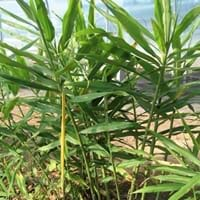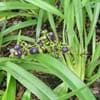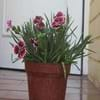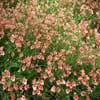Type
Tender Perennial
Grass
Origin
Southern Asia, India, China, Melanesia, Micronesia, Australia
South America, Micronesia, New Zealand
Types
Not Available
Not Available
Number of Varieties
Not Available
Habitat
agricultural areas, Moist Soils, Warmer regions
coastal environs, Grassland, Roadsides, Waste areas, waterways
USDA Hardiness Zone
Not Available
7-11
AHS Heat Zone
Not Available
11 - 7
Sunset Zone
Not Available
H1, 3a, 3b, 4, 5, 6, 7, 8, 9, 10, 11, 12, 13, 14, 15, 16, 17, 18, 19, 20, 21, 22, 23, 24
Habit
Clump-Forming
Clump-Forming
Flower Color
White, Red, Green, Orange, Pink, Magenta, Fuchsia, Rose, Lavender
Purple
Flower Color Modifier
Bicolor
Bicolor
Fruit Color
Not Available
Not Available
Leaf Color in Spring
Green, Dark Green
Green, Light Green, Dark Green
Leaf Color in Summer
Green, Dark Green
Light Green
Leaf Color in Fall
Green, Dark Green
Green, Light Green, Dark Green
Leaf Color in Winter
Light Green
Dark Green, Tan
Leaf Shape
Linear
Grass like
Plant Season
Not Available
Spring, Summer, Fall, Winter
Sunlight
Partial Sun
Full Sun
Type of Soil
Not Available
Loam
The pH of Soil
Not Available
Acidic, Neutral
Soil Drainage
Moist
Well drained
Bloom Time
Indeterminate
Summer, Fall
Repeat Bloomer
Not Available
No
Tolerances
Drought
Drought, Salt
Where to Plant?
Container, Ground
Ground
How to Plant?
From Rhizomes
Seedlings
Plant Maintenance
Medium
Medium
Watering Requirements
Do Not over Water, Keep ground moist
Average Water Needs
In Summer
Adequately
Lots of watering
In Spring
Moderate
Moderate
In Winter
Less Watering
Average Water
Soil pH
Not Available
Acidic, Neutral
Soil Type
Not Available
Loam
Soil Drainage Capacity
Not Available
Well drained
Sun Exposure
Partial Sun
Full Sun
Pruning
Remove damaged leaves, Remove dead branches, Remove dead leaves
Remove damaged leaves, Remove dead branches, Remove dead leaves
Fertilizers
All-Purpose Liquid Fertilizer
All-Purpose Liquid Fertilizer
Pests and Diseases
Bacteria wilt, Bacterial Blight, Rhizome rot, Root knot nematode
Red blotch
Plant Tolerance
Drought
Drought
Flower Petal Number
Single
Single
Fragrant Fruit
Not Available
No
Fragrant Leaf
Not Available
No
Fragrant Bark/Stem
Not Available
No
Foliage Texture
Not Available
Fine
Foliage Sheen
Not Available
Matte
Self-Sowing
Not Available
Yes
Attracts
Butterflies, Flying insects
Not Available
Allergy
Heartburn, Stomach burn
Itchiness
Aesthetic Uses
Beautification, Ground Cover
Showy Purposes
Beauty Benefits
Acne, For treating wrinkles, Nourishes scalp, Speed hair growth
Not Available
Edible Uses
Yes
Sometimes
Environmental Uses
Indoor Air Purification, Provides ground cover, soil stabilisation
Air purification
Medicinal Uses
Cold, Dysentry, High cholestrol, Rheumatoid arthritis, Skin Disorders, Treat Parasitic Intestinal Worms, Weight management and satiety
Not Available
Part of Plant Used
Leaves, Rhizomes
Flowers, Leaves
Other Uses
Can be made into a herbal tea, Cosmetics, Oil is used in perfume, soaps, creams, etc., Used as Ornamental plant, Used as a spice
Animal Feed, Used as Ornamental plant
Used As Indoor Plant
Yes
No
Used As Outdoor Plant
Yes
Yes
Garden Design
Container, Cutflower, Houseplant, Tropical
Cutflower, Dried Flower/Everlasting, Feature Plant, Foundation, Groundcover, Mixed Border, Screening / Wind Break
Botanical Name
CURCUMA
CORTADERIA jubata
Common Name
Ginger
Purple Pampas Grass
In Hindi
अदरक
Purple pampas grass
In German
Ingwer
Lila Pampasgras
In French
Gingembre
Pourpre herbe de pampa
In Spanish
Jengibre
hierba púrpura pampas
In Greek
Τζίντζερ
Μωβ γρασίδι παμπάς
In Portuguese
Gengibre
grama roxa pampas
In Polish
Imbir
Purpurowy trawa pampasów
In Latin
gingiber
Purpura Pampas herba
Phylum
Magnoliophyta
Magnoliophyta
Class
Liliopsida
Liliopsida
Order
Zingiberales
Poales
Family
Zingiberaceae
Poaceae
Genus
Zingiber Mill.
Cortaderia
Clade
Angiosperms, Commelinids, Monocots
Angiosperms, Commelinids, Monocots
Tribe
Not Available
Not Available
Subfamily
Not Available
Not Available
Number of Species
Not Available
Not Available
Importance of Ginger Plant and Purple Pampas Grass
Want to have the most appropriate plant for your garden? You might want to know the importance of Ginger Plant and Purple Pampas Grass. Basically, these two plants vary in many aspects. Compare Ginger Plant and Purple Pampas Grass as they differ in many characteristics such as their life, care, benefits, facts, etc. Every gardener must at least have the slightest clue about the plants he wants to plant in his garden. Compare their benefits, which differ in many ways like facts and uses. The medicinal use of Ginger Plant is Cold, Dysentry, High cholestrol, Rheumatoid arthritis, Skin Disorders, Treat Parasitic Intestinal Worms and Weight management and satiety whereas of Purple Pampas Grass is Not Available. Ginger Plant has beauty benefits as follows: Acne, For treating wrinkles, Nourishes scalp and Speed hair growth while Purple Pampas Grass has beauty benefits as follows: Acne, For treating wrinkles, Nourishes scalp and Speed hair growth.
Compare Facts of Ginger Plant vs Purple Pampas Grass
How to choose the best garden plant for your garden depending upon its facts? Here garden plant comparison will help you to solve this query. Compare the facts of Ginger Plant vs Purple Pampas Grass and know which one to choose. As garden plants have benefits and other uses, allergy is also a major drawback of plants for some people. Allergic reactions of Ginger Plant are Heartburn and Stomach burn whereas of Purple Pampas Grass have Itchiness respectively. Having a fruit bearing plant in your garden can be a plus point of your garden. Ginger Plant has no showy fruits and Purple Pampas Grass has showy fruits. Also Ginger Plant is not flowering and Purple Pampas Grass is not flowering . You can compare Ginger Plant and Purple Pampas Grass facts and facts of other plants too.





